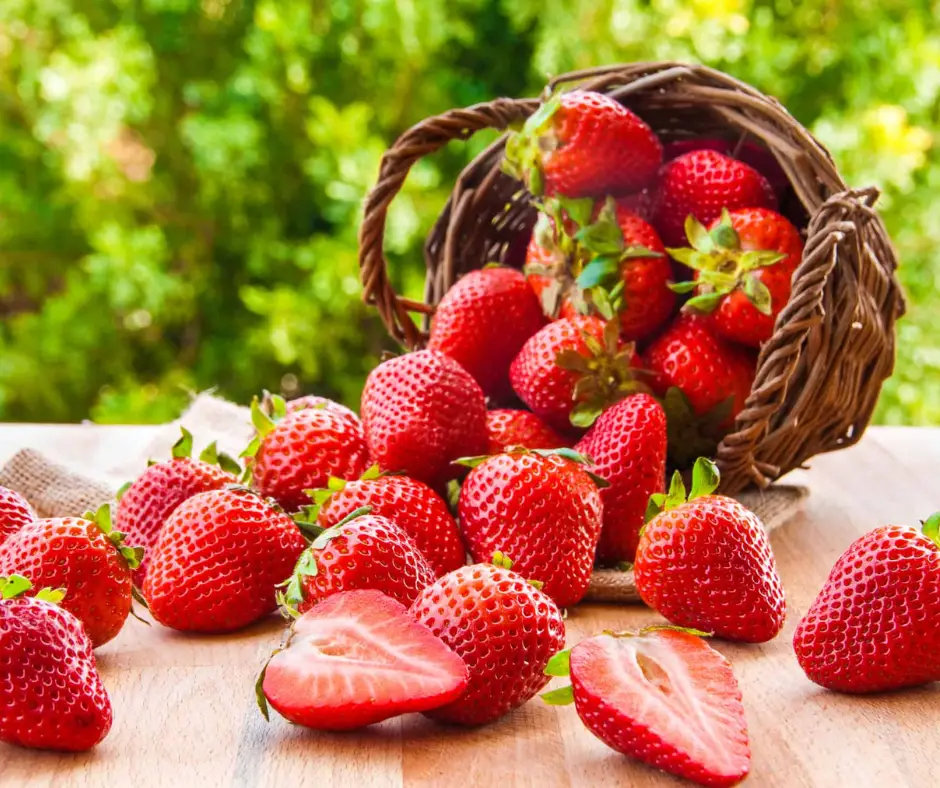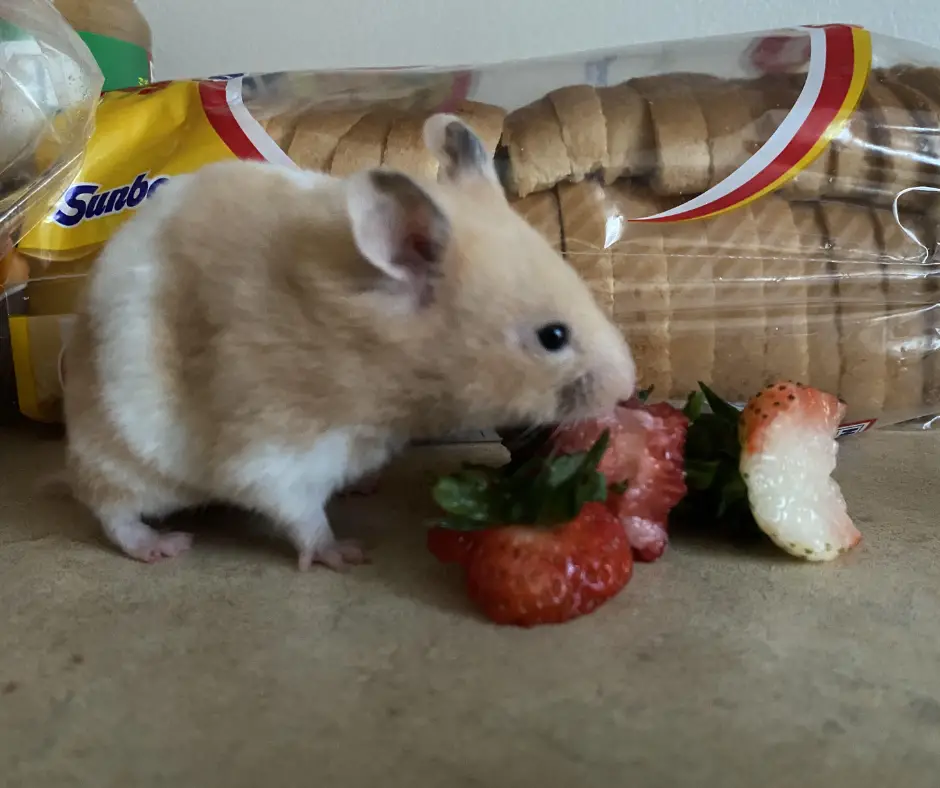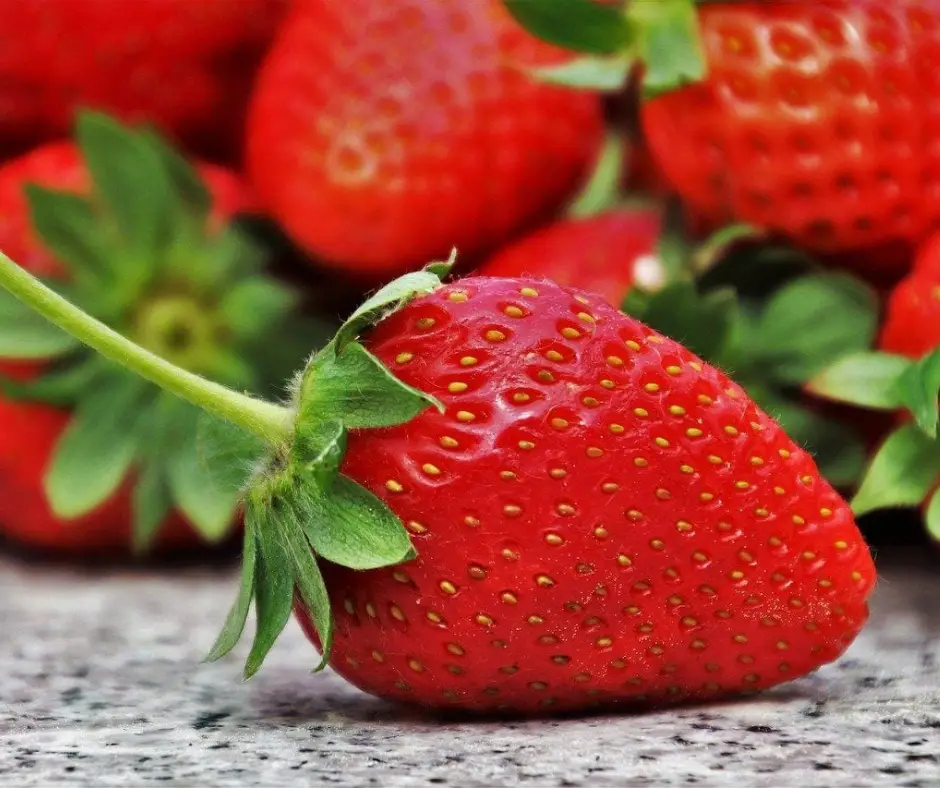Introduction
Hamsters are adorable furry creatures that make great pets. As a responsible pet owner, providing them with a balanced and nutritious diet is important to ensure their health and well-being. Many hamster owners may wonder if they can feed strawberries to their furry friends. In this guide, we will explore the topic of hamster nutrition and answer the question: can hamsters eat strawberries?

The Importance Of A Balanced Diet For Hamsters
Just like humans, hamsters require a balanced diet to stay healthy. A proper diet ensures they receive all the essential nutrients needed to support their growth, immunity, and overall well-being. A well-balanced hamster diet typically consists of commercial pellets, fresh vegetables, fruits, and occasional treats.
Understanding The Nutritional Needs Of Hamsters
Before introducing any new food to your hamster’s diet, it’s important to understand their nutritional needs. Hamsters require a diet high in carbohydrates, moderate in protein, and low in fats. They also need essential vitamins, minerals, and fiber to support their health.
When feeding strawberries to hamsters, they can be considered a safe treat in moderation. Strawberries are rich in vitamin C, essential for a hamster’s immune system, and contain antioxidants that can provide some health benefits. However, it’s important to remember that strawberries should be given in small amounts and as an occasional treat.
To ensure the safety of feeding strawberries to your hamster, wash them thoroughly and remove any stems before offering them. It’s also a good idea to introduce strawberries gradually into their diet and monitor their reaction. If you notice any discomfort, digestive issues, or allergies, discontinue feeding strawberries and consult a veterinarian for guidance.
In addition to strawberries, there are other safe treat options that you can offer your hamster to provide variety in their meals. Apples, carrots, and cucumbers are suitable alternatives that are low in fat and provide vitamins and fiber.
Remember, a balanced and varied diet with proper portion control is key to keeping your hamster healthy and happy. Consulting with a veterinarian for specific dietary recommendations and regular check-ups is always a good idea to ensure your hamster’s well-being.
Overall, hamsters can enjoy strawberries as a tasty and occasional treat. Just remember to offer them in moderation and always prioritize their regular diet to provide all the essential nutrients they need.
Can Hamsters Eat Strawberries?
So, Can Hamsters Eat Strawberries? Hamsters can eat strawberries, but it is important to feed them in moderation and take certain precautions. Strawberries are a delicious treat that can provide several nutritional benefits for your furry friend. However, it is crucial to understand the proper way to incorporate strawberries into a hamster’s diet to ensure their well-being.
Benefits Of Strawberries For Hamsters
Strawberries are rich in vitamin C, which is vital to maintaining a hamster’s health. They also contain antioxidants that help combat inflammation and promote heart health. Additionally, strawberries contain fiber and water, contributing to a healthy digestive system and proper hydration for your hamster.
Guidelines For Feeding Strawberries To Hamsters
When offering strawberries to your hamster, it is important to follow these guidelines:
- Moderation: Strawberries should be given to hamsters as a treat, not a substitute for their regular diet. Too many strawberries can lead to weight gain, digestive issues, and potential health problems.
- Preparation: Remove the stem and leaves before offering strawberries to your hamster, as they can pose a choking hazard. Cut the strawberry into small, bite-sized pieces your hamster can easily consume.
- Introduce Gradually: If your hamster has never had strawberries, introduce them gradually. Start by offering a small piece and observe their reaction over the next 48 hours. If there are any signs of adverse reactions such as diarrhea or loss of appetite, discontinue feeding strawberries immediately and consult your veterinarian.
- Washing: Always wash strawberries thoroughly before giving them to your hamster. Many commercially grown strawberries are treated with pesticides, which can harm your pet. Opting for organic strawberries or rinsing them before serving is the best way to ensure their safety.
Here’s a summary of the guidelines for feeding strawberries to your hamster:
| Guidelines | Details |
|---|---|
| Moderation | Treat, not a main diet |
| Preparation | Remove stem and leaves |
| Introduction | Start with a small piece |
| Monitoring | Observe reactions closely |
| Washing | Thoroughly rinse or choose organic strawberries |
Remember, while strawberries can be a delightful and nutritious addition to your hamster’s diet, it is important to prioritize their regular diet of pellets, vegetables, and hay. Consult with your veterinarian for personalized advice on your hamster’s dietary needs.
Other Fruits And Vegetables For Hamsters
While strawberries can be safe for hamsters in small amounts, many other fruits and vegetables can also be included in their diet. It’s important to offer various options to ensure your furry friend a balanced and nutritious meal.
Here are some safe and healthy fruits and vegetables that you can consider adding to your hamster’s diet:
- Dates: Dates are a good source of fiber and provide essential minerals like potassium and magnesium.
- Pomegranate: Pomegranate is rich in antioxidants and can help boost the immune system.
- Elderberries: Elderberries are high in fiber and vitamin C, supporting digestive health and strengthening the immune system.
- Raspberry: Raspberries are packed with antioxidants and provide vitamins C and K.
- Figs: Figs are a great dietary fiber, calcium, and potassium source.
- Starfruit: Starfruit is low in calories and high in vitamin C.
- Gooseberries: Gooseberries are rich in vitamin C and can help improve cardiovascular health.
- Grapes (seedless): Grapes are a hydrating fruit that contains vitamins and minerals.
- Tomatoes (ripe): Ripe tomatoes are a good source of vitamin C and antioxidants.
It’s important to note that these fruits and vegetables should be given in moderation and introduced gradually into your hamster’s diet to prevent digestive issues.
Best Practices For Introducing New Foods To Hamsters
When introducing new foods to your hamster, following some best practices is essential to ensure their health and well-being. Here are some tips to keep in mind:
- Start small: Begin by offering a small piece of the new food and observe your hamster’s reaction. If they show signs of allergies or digestive upset, discontinue the food and consult a veterinarian.
- Introduce new foods gradually, mixing them with the current diet. This will help your hamster adjust to the new flavors and textures without causing sudden changes in their digestive system.
- Monitor for allergies: Keep a close eye on your hamster for any signs of allergies, such as itching, sneezing, or swelling. If these symptoms occur, remove the food from their diet and seek veterinary advice.
- Offer a varied diet: To ensure a well-balanced diet, offer a variety of fruits, vegetables, and hamster-specific pellets. This will provide essential nutrients and promote overall health.
- Avoid toxic foods: Some fruits and vegetables, such as onions, garlic, citrus fruits, and avocado, can be toxic to hamsters. Do thorough research and avoid offering any potentially harmful foods.
Remember, while fruits and vegetables can be a healthy addition to your hamster’s diet, their main source of nutrition should come from commercially available hamster food. These foods are specially formulated to provide all your little pet’s essential nutrients.
Ensuring a balanced diet and monitoring your hamster’s intake will help keep them healthy and happy. Consult with a veterinarian for specific recommendations tailored to your hamster’s nutritional needs.
Strawberries can be a tasty and nutritious treat for your hamster when given in moderation. However, it’s crucial to provide a well-rounded diet by incorporating a variety of safe fruits and vegetables. Always prioritize your hamster’s health and consult a veterinarian if you have any concerns or questions about their diet.
Creating A Balanced Diet For Your Hamster
When it comes to feeding your hamster, a balanced diet is essential for their overall health and well-being. While hamsters are small, they have specific dietary requirements that must be met to fulfill their nutritional needs. One common question that arises is ‘Can Hamsters Eat Strawberries?’. Let’s explore this further and discuss the importance of a balanced diet for your furry friend.
Recommended Balance Of Pellets, Vegetables, And Fruits
To create a balanced diet for your hamster, it’s crucial to understand the recommended proportions of pellets, vegetables, and fruits. This will help ensure that your hamster receives all the necessary nutrients.
- Pellets: Pellets should make up the majority of your hamster’s diet. These specially formulated pellets are designed to provide your hamster’s necessary vitamins, minerals, and proteins. Ensure the pellets suit your hamster’s specific breed and age.
- Vegetables: Vegetables are an essential part of your hamster’s diet. They provide vital vitamins, minerals, and fiber. Recommended vegetables for hamsters include carrots, broccoli, cauliflower, and spinach. These should be given in small portions to avoid overfeeding.
- Fruits: Fruits can be offered as occasional treats for your hamster. While hamsters can eat strawberries, it’s important to remember that strawberries are high in sugar. Therefore, they should be given in moderation and small pieces. Other suitable fruits for hamsters include apples, bananas, pears, and melons.
Importance Of Monitoring Portion Sizes For Your Hamster
Portion control is crucial when it comes to feeding your hamster. Overfeeding can lead to obesity and related health issues, while underfeeding can result in malnutrition. Monitoring and controlling the portion sizes of pellets, vegetables, and fruits is important to maintain a healthy balance.
To ensure proper portion sizes, offer small amounts of fruits and vegetables at a time. It’s a good idea to cut strawberries into small pieces, about the size of your hamster’s head, to prevent choking hazards. Additionally, observe your hamster’s reaction to certain foods, including strawberries. If any adverse reactions occur, such as diarrhea or lethargy, discontinue feeding that food and consult with a veterinarian.
In conclusion, hamsters can safely eat strawberries as a balanced diet. However, offering them in moderation is essential due to their high sugar content. By following the recommended balance of pellets, vegetables, and fruits and monitoring portion sizes, you can ensure that your hamster receives a nutritious diet that promotes optimal health and well-being. Always consult a veterinarian if you have any specific concerns or questions about your hamster’s dietary needs.
Next Blog Section: Best Hamster Cages for a Comfortable Habitat
Common Dietary Issues In Hamsters

Hamsters are small and delicate pets that require a balanced and nutritious diet to thrive. However, there are some common dietary issues that hamster owners should be aware of.
One of the main issues is a lack of variety in their diet. Hamsters often rely on a single type of commercial pellet for their main source of nutrition. While these pellets are designed to provide a balanced diet, they may not offer the variety and enrichment that hamsters need.
Another issue is overfeeding. Hamsters have a small digestive system and can easily become overweight if they consume too much food. This can lead to health problems such as diabetes and heart disease.
Signs Of Nutritional Deficiencies In Hamsters
It’s important to recognize the signs of nutritional deficiencies in your hamster. Some common signs include:
- Dull or unkempt fur: A lack of essential nutrients can cause a hamster’s fur dull, brittle, and unkempt.
- Weight loss or poor growth: If your hamster is not gaining weight or growing healthy, it may be a sign of malnutrition.
- Lethargy or decreased activity: Hamsters not getting enough nutrients may appear lethargic and have decreased activity levels.
- Dental issues: A lack of certain nutrients can lead to dental problems in hamsters, such as overgrown teeth or tooth decay.
How To Address Dietary Issues In Hamsters?
Providing a varied and nutritious diet is important to address dietary issues in hamsters.
- Offer a mix of fresh fruits and vegetables: Strawberries can be a safe and occasional treat for hamsters, but they should not be their main source of nutrition. Provide a mix of fresh fruits and vegetables to ensure they get a wide range of nutrients.
- Supplement with high-quality pellets: Choose high-quality hamster pellets specifically formulated to meet their nutritional needs. These pellets should make up a portion of their daily diet.
- Limit treats and high-sugar foods: While hamsters may enjoy sweet treats, limiting their sugary foods is important. Too much sugar can lead to weight gain and other health issues.
- Provide plenty of fresh water: Access to clean and fresh water is crucial for a hamster’s overall health. Make sure to change their water daily and provide a water bottle that is easily accessible.
Addressing dietary issues and providing a balanced diet can ensure your hamster stays healthy and happy. Remember to monitor their weight, activity levels, and overall appearance to catch any signs of nutritional deficiencies early on.
Treats And Snacks For Hamsters
Understanding The Role Of Treats In Hamster Diets
When it comes to treating our furry friends, choosing healthy and safe snacks for their consumption is essential. Hamsters, in particular, have specific dietary requirements that must be considered when selecting treats.
Treats should not make up a significant portion of a hamster’s diet. Instead, they should be seen as occasional snacks or rewards for good behavior. It’s important to remember that most of a hamster’s nutrition should come from a balanced diet of commercial pellets, fresh vegetables, and hay.
The key is to choose nutritionally beneficial treats that do not contain harmful ingredients. This ensures that the treats supplement their diet rather than replace important nutrients.
Healthy And Safe Treat Options For Hamsters
One popular treat option for hamsters is strawberries. Strawberries are rich in vitamin C and contain antioxidants that can support heart health and reduce inflammation. However, feeding strawberries to hamsters is crucial in moderation and with caution.
Strawberries should be given to hamsters in small portions, gradually introducing them to their diet. This allows for proper digestion and prevents any adverse reactions. It’s also essential to wash strawberries before feeding them to remove pesticides or chemicals.
While strawberries can be a good treat option, it’s important to note that not all hamsters will enjoy them. Like humans, hamsters have individual tastes; some may not like strawberries. Other options are available if your hamster doesn’t show interest in this treat.
Some other safe and healthy treatment options for hamsters include:
- Small pieces of fresh vegetables such as carrots, cucumbers, or bell peppers.
- Occasional nuts, such as unsalted almonds or hazelnuts, in small quantities.
- Dried fruit treats specifically designed for hamsters. These should be given sparingly due to their high sugar content.
- Commercial hamster treats that are formulated to meet their nutritional needs. These treats are often fortified with essential vitamins and minerals.
It’s important to remember that treats should always be given in moderation. Overindulging in treats can lead to weight gain, digestive issues, and other health problems for hamsters. Also, always consult with a veterinarian if you have any concerns about your hamster’s diet or notice any adverse reactions to certain treats.
In conclusion, treats can be a fun part of a hamster’s diet. However, choosing healthy, safe treats that do not replace important nutrients is crucial. Strawberries can be a safe treatment option for hamsters, but they should be given in small portions and with caution to prevent digestion or health issues.
Precautions And Considerations
There are a few important precautions and considerations regarding ‘Can Hamsters Eat Strawberries?’.
Potential Allergies And Reactions To Strawberries
Like humans, hamsters can develop allergies or experience adverse reactions to certain foods, including strawberries. While allergies to strawberries are rare in hamsters, it is still essential to monitor your pet’s reaction after introducing this fruit to their diet. Some hamsters may experience gastrointestinal issues or allergic reactions after consuming strawberries. If you notice any signs of discomfort, such as diarrhea or loss of appetite, it’s best to discontinue feeding strawberries and consult a veterinarian for guidance.
Consulting With A Veterinarian For Specific Dietary Needs

Every hamster is unique, and their dietary needs can vary. While strawberries are generally safe for hamsters in moderation, providing a balanced diet that meets their specific nutritional requirements is essential. Consulting with a veterinarian can help ensure your hamster’s diet is appropriate for their age, breed, and overall health. A veterinarian can guide including strawberries in your hamster’s diet and recommend other safe treatment options to promote their well-being.
To summarize, while strawberries can be a tasty and nutritious treat for hamsters, it’s crucial to introduce them gradually, in moderation, and monitor your pet’s reaction. If your hamster shows any signs of allergies or adverse reactions, it’s best to discontinue feeding strawberries and seek professional advice. Consulting with a veterinarian can help ensure that your hamster’s dietary needs are met and that they remain healthy and happy.
FAQ about Can Hamsters Eat Strawberries?
Note: Before introducing any new foods into your hamster’s diet, it is essential to consult with your veterinarian to ensure they are suitable for your specific hamster and their dietary needs.
Q: Can hamsters eat strawberries?
A: Yes, most hamsters can safely eat strawberries as a small supplement to their daily diet.
Q: Are strawberries safe for hamsters?
A: Strawberries are safe for hamsters when given in small doses and introduced gradually to avoid upsetting their digestive system. However, strawberries should not replace vital nutrients found in their normal mixed-grain diet.
Q: Why are strawberries considered healthy for hamsters?
A: Strawberries are rich in important nutrients such as vitamin C, antioxidants, fiber, and water. Vitamin C is essential for healthy eyes and heart function and for repairing damaged cells. The fiber content supports a healthy gastrointestinal system and helps keep hamsters hydrated.
Q: Can hamsters develop allergies or adverse reactions to strawberries?
A: Some hamsters may be allergic to strawberries, so it’s crucial to observe their reaction closely the first time they eat them. Signs of adverse reactions include diarrhea, lethargy, or gastrointestinal upset. If any of these symptoms persist for more than 48 hours, consult your veterinarian for further guidance.
Q: How much strawberry can a hamster eat?
A: Strawberries should be fed in moderation. Typically, hamsters should have no more than one teaspoon of mixed fruit, including strawberries, twice per week.
Q: Can all hamster breeds eat strawberries?
A: While most hamsters can safely consume strawberries, dwarf hamsters, such as Chinese Dwarf hamsters, are at higher risk of diabetes. It’s best to avoid feeding them high-sugar fruits like strawberries. Consult your veterinarian to determine the best diet for your hamster breed.
Q: Can hamsters eat dried strawberries?
A: It is not recommended to feed hamsters dried strawberries as they are higher in sugar and calories. Stick to fresh strawberries in small quantities.
Q: How should strawberries be prepared for hamsters?
A: Before feeding strawberries to your hamster, thoroughly wash them to remove any pesticides or chemical residue. Cut the strawberries into small pieces to make it easier for your hamster to eat.
Q: Can hamsters store strawberries?
A: Hamsters habitually store food, including strawberries, in their cage. It’s crucial to monitor their hiding spots and remove any hidden pieces of fruit that may rot and become harmful.
Q: Can strawberries treat certain health issues in hamsters?
A: While strawberries offer some health benefits, such as antioxidant properties, they do not cure specific health issues such as wet tails or cancer. If your hamster shows signs of illness, consult your veterinarian for appropriate treatment.
Expert Answers And Advice For Hamster Owners
Hamsters can enjoy the occasional treat of strawberries, as they provide additional nutrients and hydration. However, it is crucial to remember that strawberries should not replace the main nutrition obtained from a hamster’s regular diet of pellets, vegetables, and hay. Offering a varied diet to your hamster is important to ensure they receive a balanced intake of nutrients.
When introducing strawberries to your hamster’s diet, start with a small piece and monitor their reaction. Always wash strawberries thoroughly to remove pesticides, and consider opting for organic strawberries if possible. It is also essential to check your hamster’s cage for any hidden pieces of fruit to prevent mold growth.
Remember to consult your veterinarian if you are unsure about giving strawberries to your hamster, especially if they have a higher risk of diabetes, such as dwarf or Campbell’s hamsters. Your vet can provide specific dietary recommendations based on your hamster’s breed and health condition.
In conclusion, if given in moderation, strawberries can be a tasty and nutritious addition to your hamster’s diet. As responsible pet owners, it is important to prioritize your hamster’s well-being and consult professional advice when in doubt.
Conclusion
Now you should know the answer to ‘Can Hamsters Eat Strawberries?’. When feeding strawberries to your pet hamster, it is important to exercise caution and moderation. While strawberries can be a tasty and nutritious treat for your furry friend, they should not be the sole focus of their diet. The high sugar content in strawberries can harm hamsters, especially those at risk of diabetes. Providing a balanced and varied diet that includes a mix of commercial pellets, fresh vegetables, fruits, and occasional nuts or eggs is crucial. Consult with your veterinarian to ensure your hamster receives all the nutrients for optimal health.
Importance Of Providing A Balanced And Varied Diet For Hamsters
Hamsters, like any other pets, require a balanced and varied diet to thrive. Commercial hamster pellets contain the essential nutrients your hamster needs and should make up the foundation of their diet. However, it is essential to supplement their diet with fresh vegetables and fruits, as these provide additional vitamins and minerals. Offering a variety of foods ensures your hamster receives a diverse range of nutrients and helps prevent nutritional deficiencies. Remember to introduce new foods gradually to avoid digestive upset and monitor your hamster’s reaction to different foods.
Key Takeaways For Feeding Strawberries To Your Pet Hamster
Here are the key takeaways when it comes to feeding strawberries to your pet hamster:
- Strawberries are safe for hamsters to eat in small quantities and can be part of a balanced diet.
- Introduce strawberries slowly and in small doses to avoid digestive upset.
- Do not use strawberries as a substitute for the essential nutrients found in hamster pellets.
- Hamsters have individual preferences, so if your hamster does not like strawberries, provide alternative treats they enjoy.
- Always wash strawberries thoroughly to remove pesticides or chemicals before offering them to your hamster.
- Avoid offering dried strawberries to your hamster as they are high in calories and sugar, increasing the risk of obesity and diabetes.
- If any adverse reactions occur after feeding strawberries, such as diarrhea, vomiting, or loss of appetite, discontinue feeding and consult a veterinarian.
Remember, the health and well-being of your hamster should always be a priority. A balanced and nutritious diet and regular veterinary check-ups will help ensure your furry friend lives a happy and healthy life.

James Robinson loves coffee and blogging all about coffee. His blog is full of informative posts about the best ways to enjoy coffee and the many different types of coffee out there. He also shares recipes for delicious coffee-based dishes, and his followers can always count on him to offer tips on how to improve their coffee-making skills.
